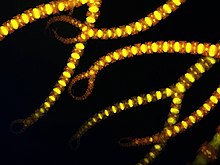en
names in breadcrumbs


Ceramium is a genus of Ceramium algae (or Rhodophyta). It is a large genus with at least 15 species in the British Isles.[1]
The fully corticated group previously referred to as Ceramium rubrum, an illegitimate name, is represented, in the British Isles by: Ceramium pallidum, Ceramium botryocarpum, Ceramium nodulosum and Ceramium secundatum.[1][2]
All species of Ceramium are small algae growing to no more than 30 cm (12 in) in length. They consist of a terete monosiphonous[3] axis of cells surrounded by smaller cells forming a cortex. In most species this a continuous cortex enclosing the axis, in others the cortical cells are arranged only in nodes at the junction of cells of the axes. The tips of the branches grow in a pincer-like manner.[4] Species in the genus show irregular branching and are attached by unicellular or branched rhizoids.[1]
The species is dioecious forming spermatangia and carpogonia on separate male and female plants. The fertilised carpogonium develops growing parasitically attached to the female plant. Tetraspores are born in the cortical bands.[1]

Scotland: Orkney and Faroes, Shetland, Ross and Cromarty, Fife.[1] England and Wales: Pembroke, Hampshire, Dorset, Devon and Cornwall, Sussex, Lincoln to Kent, Norfolk also the Channel Isles. Ireland: Cork, Kerry, Clare, Mayo, Waterford, Dublin, Donegal,[5] Antrim and Down.[1][2]
Some species are probably cosmopolitan. Widely in north-west Atlantic, Iceland, Norway to Spain, Denmark, Netherlands, France, Portugal, Mediterranean, Azores, Canary Islands, Cape Verde Islands, USA - Newfoundland to New York, Australia.[1]
Ceramium is a genus of Ceramium algae (or Rhodophyta). It is a large genus with at least 15 species in the British Isles.
The fully corticated group previously referred to as Ceramium rubrum, an illegitimate name, is represented, in the British Isles by: Ceramium pallidum, Ceramium botryocarpum, Ceramium nodulosum and Ceramium secundatum.
Ceramium es un género de algas rojas (Rhodophyta) en el que se incluyen al menos 15 especies del Atlántico Norte.
Son especies de pequeño tamaño que casi nunca alcanzan los 30 cm de longitud. Formadas por un eje monosifónico de células rodeadas por otras más pequeñas que forman un cortex.[1] En la mayoría de las especies es un córtex continuo que envuelve al eje, en el resto las células corticales están solo rodeadas en los nudos de las uniones de los ejes. Las especies muestran ramificaciones irregulares y se acompañan de rizoides unicelulares ramificados.
Las especies son dioicas con gametangios y carpogonios. El carpogonio fertilizado se desarrolla creciendo como parásito de la planta femenina. Las tetrasporas se forman en las bandas corticales.[2][3]
Su distribución es probablemente cosmopolita. Género ampliamente distribuido en el Atlántico noroccidental, Islandia, de Noruega a España, Dinamarca, Países Bajos, Francia, Portugal, Mediterráneo, Azores, archipiélagos canario y de Cabo Verde, así como en Norteamérica, de Terranova a Nueva York, y Australia.[2]
Ceramium es un género de algas rojas (Rhodophyta) en el que se incluyen al menos 15 especies del Atlántico Norte.
Son especies de pequeño tamaño que casi nunca alcanzan los 30 cm de longitud. Formadas por un eje monosifónico de células rodeadas por otras más pequeñas que forman un cortex. En la mayoría de las especies es un córtex continuo que envuelve al eje, en el resto las células corticales están solo rodeadas en los nudos de las uniones de los ejes. Las especies muestran ramificaciones irregulares y se acompañan de rizoides unicelulares ramificados.
Las especies son dioicas con gametangios y carpogonios. El carpogonio fertilizado se desarrolla creciendo como parásito de la planta femenina. Las tetrasporas se forman en las bandas corticales.
Su distribución es probablemente cosmopolita. Género ampliamente distribuido en el Atlántico noroccidental, Islandia, de Noruega a España, Dinamarca, Países Bajos, Francia, Portugal, Mediterráneo, Azores, archipiélagos canario y de Cabo Verde, así como en Norteamérica, de Terranova a Nueva York, y Australia.
Ceramium est un genre d'algues rouges de la famille des Ceramiaceae, comprenant environ 200 espèces.
Ceramium vient du grec « en forme de corne »[1], illustrant la morphologie des apex fourchus ou « extrémités enroulées en crosse ».
Une autre hypothèse fait remonter l'étymologie au grec ceramion, céramique, terme impropre car s'appliquant à l'origine à la description des structures reproductives de Gracilaria qui ressemblent à des cruches en céramique[2].
Toutes les espèces de Ceramium sont des algues au thalle filamenteux à la ramification dichotomique irrégulière, de couleur rouge clair à rouge bordeaux. Leur développement n'excède pas 30 cm de longueur. L'apex fourchu de leurs filaments montre deux pointes caractéristiques, en forme de cornes ou de pince.
Elles croissent sous forme de touffes depuis la zone intertidale moyenne jusqu'à la zone subtidale (jusqu'à 30 m de profondeur), typiquement dans les flaques littorales, sur les rochers ou en épiphyte sur les autres algues.
Des espèces de ce groupe ont été étudiées pour certains de leurs composés présentant des caractéristiques antibiotiques[3], pour leurs pigments photosynthétiques[4], du point de vue de leur capacité à bioaccumuler certains polluants (par exemple présents dans les sédiments portuaires de la côte ouest de la Suède[5], pour certains de leurs composés biochimiques (ex : Amino-acides proches des mycosporines[6], en tant qu'espèces potentiellement bioindicatrices de pollution marine[7] ou à absorber certains polluants (composés aromatiques bromés par exemple[8]). Cette algue rouge pourrait être utilisée comme biosorbant pour extraire des ions cuivre (Cu 2+) d'eau polluée (le cuivre, largement utilisé dans les antifooling est hautement toxique pour de nombreux micro-organismes aquatiques (marins notamment)[9].
Certaines espèces semblent avoir ou pouvoir développer un caractère invasif là où elles ont été introduites hors de leur aire naturelle de répartition[10]
Selon AlgaeBase (26 juillet 2013)[13] :
Selon ITIS (26 juillet 2013)[14] :
Selon NCBI (26 juillet 2013)[15] :
Ceramium est un genre d'algues rouges de la famille des Ceramiaceae, comprenant environ 200 espèces.